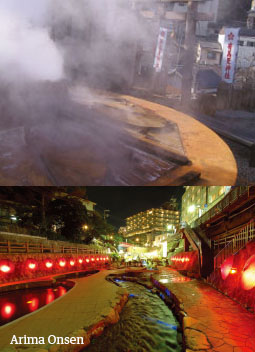Home > Highlighting JAPAN > Highlighting Japan March 2019 > From Hot Springs to Art: Japan’s Bath Culture
Highlighting JAPAN


Famous Onsen in the Country of Hot Springs
While the regions of Japan may have vastly different climates, from Hokkaido to Okinawa they all have one thing in common—onsen, or hot springs. In fact, there are over three thousand onsen areas in the country, and vast legions of people seek them out to soak and relax. Here are three select onsen from among Japan’s many renowned natural hot springs.
The Hot Spring Law enacted in 1948 defines what an onsen in Japan is supposed to be. Specifically, the term onsen refers to hot water, mineral water, water vapor or other kinds of gas (excluding natural gas with hydrocarbon as a primary component) discharged from underground, with a water source collection point temperature of 25 degrees Celsius or higher, or that contains a certain amount of at least one of the substances the government specifies (such as free carbon dioxide, radon or radium salts).
According to Ministry of the Environment research conducted in 2016, Japan has over three thousand onsen resorts, one of the world’s biggest concentrations. Blessed with so many volcanic hot springs, rich groundwater from the rainy climate, and Japanese people’s traditional fondness for bathing, it’s no surprise that Japan is an onsen paradise. Here are three remarkable onsen resorts that vividly represent the characteristics of their respective regions.
Noboribetsu Onsen
Located on the Pacific coast of southern Hokkaido, Noboribetsu boasts a 160-year history, making it the oldest onsen among Hokkaido’s 245 hot springs according to the Ministry of the Environment’s 2016 research. About ten thousand tons of hot water with temperatures of between 45 to 90 degrees Celsius at the source gush up out of the ground every day. Visitors to the town can enjoy onsen with nine different types of spring water, including a sulfur spring and a sodium bicarbonate spring. The Oyunuma River, flowing out of Oyunuma Lake in Noboribetsu, is a rare natural footbath, and the virgin forest growing along the river adds to the scenic landscape.
A popular “demon fireworks festival” takes place every year on Thursday and Friday evenings from June to July, attracting many tourists. During the event, the legendary Yukijin demons, said to reside in jigoku no tani (the Valley of Hell), shoot handheld fireworks into the night sky to ward off evil influences.
Gero Onsen
Situated in central Gifu Prefecture, Gero Onsen has almost a thousand years of history. Legend has it that an injured heron led villagers to the hot spring’s location. The onsen is known for its jet ponds along the scenic Hida River, which offer an outstanding natural atmosphere and no fences. There are also free footbaths scattered around the resort town.
Popular attractions in Gero Onsen include bath-hopping using yumeguri tegata, a ticket that can be used up to three times at any participating onsen hotel, along with fireworks shows on Saturday nights from January to March. Called hanabi monogatari, this spectacular pyrotechnic show portrays Japanese events and customs throughout the four seasons using fireworks. Since Gero is a simple alkaline hot spring, its waters act as a natural soap, and it is nicknamed bijin no yu (hot spring of beauty) for its health and beauty-boosting effects.
Arima Onsen
This hot spring resort is in Kobe, Hyogo Prefecture, on Mount Rokko. Arima Onsen appears in mythological stories, and records show that over fourteen centuries ago the emperor at the time stayed there. During the Warring States Period (1467-1590), the great general Toyotomi Hideyoshi carried out extensive renovation work in Arima.
Arima’s waters contain seven of the nine substances the Ministry of the Environment designates as effective for medical treatment. Even globally it is rare for a single hot spring to have so many diverse chemical components. Of the three types of onsen in Arima, the most famous is the kinsen, or Gold Spring, a high-temperature ferruginous sodium chloride spring also known as “red water” because it turns rusty red when it meets the air. The water source is within the grounds of Arima Tenjin Shrine, which enshrines the same god as the famous Kitano Tenmangu Shrine in Kyoto. At the spring’s source the golden water is a steaming 100 degrees Celsius, steadily gushing up from 185 meters underground, but cooled to around 40 degrees for bathing. Various seasonal events also draw visitors, such as cherry blossom festivals, riverside parties and summer festivals.
The allure of an onsen depends on its history, scale, the surrounding landscape and the quality of the springs. Learning about various onsen and finding the perfect one adds to the fun of a visit to Japan’s famous hot springs.
© 2009 Cabinet Office, Government of Japan








